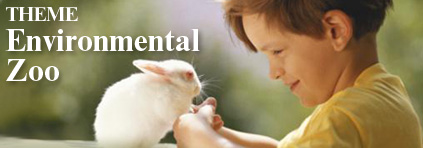42nd CG Competition

The notion of the zoo is undergoing changes. The first zoos were for the collection and display of the kinds of animals that exist on our planet, yet gradually they have become environments constructed for the viewing of ecologies. Furthermore, in recent times they have been searching for ways to communicate with animals. However, if they make a single misstep, they end up just putting on shows intended to attract crowds.
-It’s interesting.
Although zoos are certainly intended to enable the spread of human knowledge, further progress has been made with environmental zoos, in the hope of constructing new relationships with animals rather than being focused on humans. For instance, consideration may be given to what might be good relationships with humans from the standpoint of animals.
Animals are majestic in places such as the African savannas, and humans may observe them without disrupting the ecosystem.
Of course, it is necessary to ensure mutual safety.
It is said that Saint Francis could converse with birds, yet recently research has been progressing on the comprehension of the languages of animals such as dolphins and dogs. This is not merely satisfying curiosity, but is an attempt to gain a deeper understanding of animals as constituent members of our planet. An environmental zoo requires more than just a design for animal shelters or a collection of all kinds of animals. To achieve a sustainable global environment, consideration should be given to a symbiotic environment that includes the activities of humans with animals. It would be acceptable to propose animals shelters in accordance with this outline, and also acceptable to advance ideas about facilities wherein we may dwell together with the animals. From the standpoint of architectural design, proposals are wanted for notions of an environmental zoo that begins to make desirable relationships between humans and animals, not only as abstract proposals but also as expressions of reality.
Continuing on from the last competition, this one will also use a two-stage format of examining the drawings followed by public interviews. With an understanding of this outline, we hope to collect entries that comprise a foundation suitable for the construction of the future.
-Judges;
Toyo Ito Toyo Ito & Associates, Architects
Masaru Okamoto Kume Sekkei Co., Ltd.
Riken Yamamoto Riken Yamamoto & Field Shop
Kiyoshi Sakurai Nikken Sekkei Co., Ltd.
Taro Ashihara Taro Ashihara Architects
Kengo Kuma Kengo Kuma & Associates
Yutaka Suzurikawa Director, Executive Managing Officer. Central Glass Co., Ltd
-Coordinator;
Shozo Baba Architectural Communication consultant Ltd.
-Sponsor;
Central Glass Co., Ltd.
Shinkenchiku-sha Co., Ltd.
First Place (one) ¥2,000,000 and a commemorative gift
Second Places (three) ¥300,000 and a commemorative gift, each
Honorable Mentions (six) ¥100,000 and a commemorative gift, each
(All prize money tax included)
Drawings;
Plan (in any Scale), section (in any scale), site plan (in any scale), and perspective. Photographs of models may be used. You are free to append detail drawing, other charts or descriptive texts that make your design clearer. Descriptive texts must be limited to less than 100 wards in English.
Paper and Media;
* Complete all drawings, illustrative matters, and texts on one sheet of thick drawing paper (600mm×840mm).
* You may use blue prints, pencil, ink, color, or photographs; but do not use panels.
* On the back of your entry attach a piece of paper gearing your name, address, age, home and office telephone numbers (or fax numbers), e-mail address, place of occupation. All of these have to be “typewritten” for the sake of legibility.
All entries must reach competition office no later than July 25 (Wednesday), 2007.
First stage: First stage finalist (10 teams) will be notified of their selection by the end of July.
Winners will be notified by mail; results of the first stage will appear in this website (http://www.cgco.co.jp/english/environmental_zoo.html) on August 2007.
Second stage: The finalists will present their proposals at September 29, 2007 and the judges will choose the winner before the public.
The finalist will be invited to Tokyo, Japan.
Winners will be announced in the 2007 November issue of “SHINKENCHIKU” and vol. 68 issue of “THE JAPAN ARCHITECT”.
* No registrations are necessary for this competition.
* Entries must never have been made public in any from previously, nor should it be submitted simultaneously for any other competitions.
* Copyrights on the winning entries remain the property of their designers, but the sponsors of the competition retain the all rights on the announcement of these entries.
* Questions will not be answered by the sponsors. All matters not covered in the regulations listed above are left to the discretion of the entrants.
* A part of the work or all must not infringe a copyright. do not use the images copied from the magazines, books and websites. When there is the infringement of the copyright, winning will be taken back in the sponsor’s judgment.
* No entries will be returned.
* The entry would be admitted only its submission keeps all the rules appropriately.
* All necessary costs for submission (airmail charge, air courier charge, tax, insurance, etc) must be fully paid by entrants.
* Personal information of the competition entrants are shared and may be used by Central Glass Co., Ltd. and Shinkenchiku-sha. The entrants are considered that they have agreed with the use and the handling of their personal information by both parties.
* If any of the above is omitted, your entry will not be acceptable.
Dept. of Central Glass International Architectural Design Competition 2007, Shinkenchiku-sha Co., Ltd. 2-31-2 Yushima, Bunkyo-ku, Tokyo 113-8501, Japan